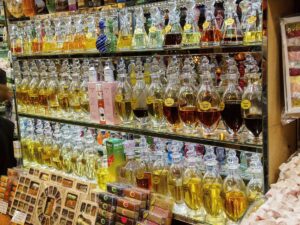Wondering how the latest fragrance market trends are shaping the industry? Exploring the key drivers and innovations currently influencing this dynamic field is crucial for your brand to stay ahead.
Our expertise is grounded in thorough research and collaboration with industry leaders, ensuring you receive information you can trust.
Fragrance market trends is continuously evolving driven by consumer preferences and technological innovations. Brands that effectively navigate these trends are positioning themselves at the forefront of the industry.
In this guide, you will discover cutting-edge trends, from consumer behavior shifts to technological advancements that are setting new standards.
Read on for strategic insights into fragrance market trends!
The fragrance industry stands as a testament to human creativity, blending together art, science, and culture. From ancient times to the modern era, fragrances have played a vital role in human expression, with each scent telling a unique story. Today, the industry is a complex blend of tradition and innovation, where classic techniques meet cutting-edge technologies to cater to a diverse global market.
The current landscape of the fragrance industry is shaped by a rich heritage and strong commitment to quality. Brands are constantly exploring new opportunities, from sourcing rare ingredients to embracing sustainable practices, to meet the evolving demands of consumers. This dynamic industry values both fragrance enjoyment and ethical manufacturing.
The fragrance industry is evolving rapidly, driven by a growing demand for personalized scents, as indicated by a projected 4.50% market growth by Market Research Future. This shift reflects a desire for individual expression and moves away from mass-produced fragrances. As a result, there’s been a rise in smaller artisanal brands offering customized scent experiences for diverse consumer preferences.
Simultaneously, the industry is embracing digital innovation, impacting how fragrances are marketed and sold. Online platforms have become crucial, allowing for direct engagement with consumers and create cool online experiences. This shift is not only expanding the market reach but also transforming consumer expectations, pushing brands towards more interactive and personalized online shopping experiences.

Technological advancements are transforming fragrance creation, allowing brands to adapt to changing preferences in the market. Here are the key technological trends:
Nanotechnology is being utilized to improve the longevity and controlled release of fragrances on the skin. Tiny carriers are being used to wrap fragrance molecules, shielding them from damage and managing how they are released over time. This enhances consumer’s experience by providing a lasting scent and reduces the frequency of application, making fragrance use more efficient and sustainable.
Ultrasonic aromatization is a cutting-edge technique that uses ultrasonic waves to create fine mists of fragrance, improving how scents spread in products. This method can produce a more uniform and subtle distribution of fragrances in personal care products, enhancing consumer experience. It also reduces the amount of raw material needed, thereby lowering production costs and environmental footprint.
Advancements in chromatography and mass spectrometry have improved the precision of scent analysis. These technologies identify and measure every component of a scent, aiding in precise matches and new fragrance discoveries. It gets better as this analytical precision supports the development of more complex and detailed fragrances. Nako Cosmetic employs advanced technology for innovative fragrance creation.
Artificial intelligence is revolutionizing fragrance development by accurately predicting scent preferences and outcomes. AI algorithms analyze extensive consumer preference data to assist in designing scents that are more likely to connect with target audiences. This approach simplifies the creation process and reduces the time and cost involved in bringing new fragrances to market.
Here’s a table that highlights the impact of AI-driven fragrance development on the industry:
| Aspect | Description | Benefit |
| Predictive Analytics | AI algorithms analyze consumer data to predict scent preferences. | Targeted Development: Ensures scents are aligned with consumer preferences, increasing market success rates. |
| Efficiency in Creation | Streamlines the process of fragrance formulation by identifying promising scent combinations. | Reduced Time and Cost: Accelerates development and lowers production costs. |
| Market Insight | Provides insights into emerging trends and consumer behavior. | Strategic Innovation: Enables brands to stay ahead of market trends and consumer demands. |
Building on the technological advancements, effective marketing strategies become crucial for brands to differentiate themselves and connect with their audience. Here are vital strategies to remember:
Partnering with celebrities or influencers who connect with the brand’s target audience can increase a fragrance’s market presence. These collaborations bring authenticity and a personal touch to the brand, as influencers share their genuine experiences with the fragrance to their followers. This approach uses the trust and connection influencers have with their followers, leading to more attention and purchases.
Content marketing offers an opportunity to educate and engage potential customers without hard selling. For example, by creating valuable content related to fragrance, like articles on scent pairing, the history of perfume, or behind-the-scenes looks at fragrance creation, brands can position themselves as industry experts. Likewise, this approach builds trust, guiding audience through purchasing with engaging content.
Capitalizing on seasonal trends and cultural moments can boost a fragrance’s relevance and appeal. By launching campaigns that align with holidays, seasons, or cultural events, brands can tap into the mood and interests of their audience. This strategy allows for the timely promotion of fragrances and enhances consumer attraction, whether for personal use or gifting purposes.
Implementing subscription or loyalty programs builds repeat business and grows a loyal customer base. Exclusive perks, discounts, or early access to new releases create a sense of belonging and appreciation among customers. Subscription models, in particular, provide the convenience of regular deliveries and the thrill of discovering new fragrances, boosting customer satisfaction and loyalty.

After exploring the innovative marketing strategies that brands are adopting, it’s crucial to understand the challenges they face in this ever-evolving industry. Here are challenges that are particularly impactful:
The clean beauty trend is pushing consumers to prefer fragrances free from synthetic chemicals and harmful ingredients. As a matter of fact, this change forces brands to adjust product formulations to meet clean standards. A solution lies in investing in research and development to create safe and natural fragrance alternatives that do not compromise on quality or scent.
The preference for online shopping has required brands to enhance their digital presence and adapt to virtual sales environments. This shift makes it challenging to convey the sensory experience of a fragrance digitally. Brands can utilize technology like augmented reality or sample delivery services to bridge this sensory gap, allowing consumers to explore scents from the comfort of their homes.

Supply chain disruptions have become more frequent, affecting the availability of raw materials and increasing costs. Such challenges make it difficult for brands to maintain steady production and pricing. Strengthening relationships with multiple suppliers and investing in local sourcing can mitigate these risks, ensuring more stable supply chains.
Ensuring compliance with international fragrance regulations is a complex challenge for brands. These regulations vary widely across countries, setting different standards for ingredient usage and product safety. Brands must continuously monitor these changing regulations to ensure their products are legally compliant in every market they serve.
Following the exploration of challenges facing the fragrance industry, it’s crucial to understand how broader global trends are influencing the sector. Here are key ways in which these trends are appearing:
A revival of vintage and classic fragrances is happening, as consumers crave for nostalgia and timeless elegance in their scent choices. For example, brands are reintroducing historic formulations with a modern twist, blending classic scents with a contemporary vibe. This trend taps into the emotional connection consumers have with scents, offering a blend of familiarity and freshness.

Health and wellness movements influence fragrance preferences and product development. Consumers are increasingly seeking fragrances that offer therapeutic benefits or are associated with health and well-being. As a result, there is a notable shift towards essential oil-based fragrances and aromatherapy products. Nako Cosmetics is adding health elements to fragrances to meet wellness demand.
The push towards sustainability has extended to packaging, with brands exploring biodegradable, recyclable, and refillable options. This shift not only reduces waste but also aligns with consumer desire for environmentally friendly products. Innovative packaging solutions are becoming a key differentiator in the market, reflecting a brand’s commitment to sustainability.

There’s a growing consumer demand for multifunctional fragrances that offer benefits beyond scent, such as mood enhancement or skin care properties. This demand is leading to the development of innovative products that combine fragrance with therapeutic or cosmetic benefits. These fragrances blend sensory delight with practical benefits, meeting the demand for versatile products of consumers.
Looking for more diverse product options? Browse through our handpicked selections:
Still haven’t found what you’re looking for? Don’t hesitate to contact us. We’re available around the clock to assist you.
Navigating the fragrance market trends is vital for industry players aiming to stay at the forefront of innovation and consumer preference. This guide has offered a comprehensive overview, empowering businesses with the knowledge to adapt and thrive in a dynamic landscape.
For those in search of unmatched fragrance manufacturing capabilities, Nako Cosmetic is the ideal collaborator. Contact us to learn about our services and how we can assist you.
Own Your Private Label Cosmetic Line Is No Longer Difficult Here!
Don't let questions and needs hold you back. Reach out to us today.
How to Start Your Beauty Business?